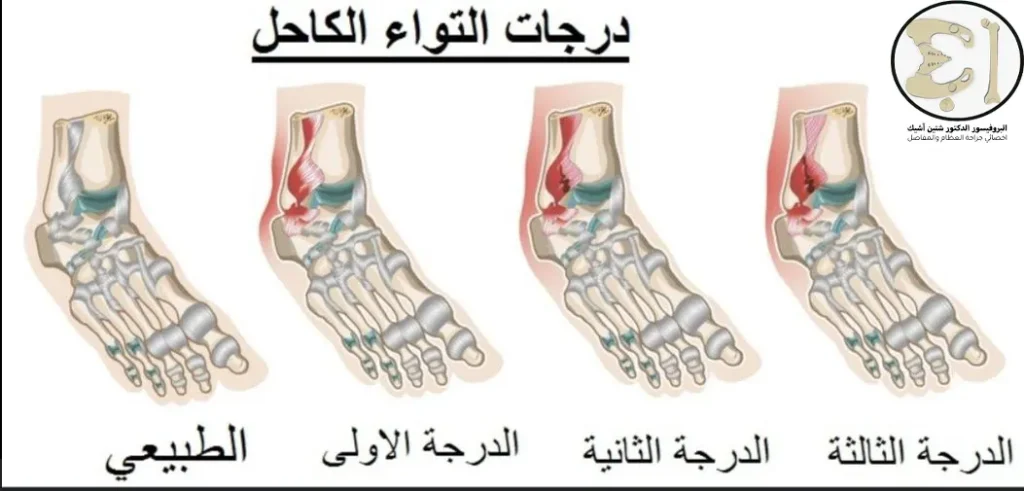ما هو التواء الكاحل؟
يُعد التواء الكاحل (Sprained Ankle) من أكثر إصابات المفاصل شيوعًا بين الرياضيين وغير الرياضيين على حد سواء. تحدث هذه الإصابة نتيجة تمزق أو تمطط في أربطة مفصل الكاحل — وهي الأنسجة الليفية القوية التي تربط العظام ببعضها وتُثبّت المفصل.
ويحدث الالتواء عادةً نتيجة حركة مفاجئة أو التواء عنيف للكاحل، مثل ثني القدم للداخل أو الخارج أثناء المشي أو القفز أو الجري. قد يكون الألم الناتج شديدًا ويصاحبه تورم أو كدمة، ولكن في أغلب الحالات يمكن علاجه بطرق غير جراحية عند تشخيصه والتعامل معه بشكل صحيح.

الفرق بين التواء الكاحل وكسر الكاحل
من المهم التمييز بين التواء الكاحل وكسر العظم في نفس المنطقة، لأنهما يتشابهان في الأعراض من حيث الألم والتورم وصعوبة الحركة.
- Sprained ankle: إصابة في الأربطة.
- كسر الكاحل: انكسار في أحد عظام المفصل.
يُشخّص الفرق عادةً من خلال الفحص السريري والتصوير الشعاعي (X-Ray)، وقد يُطلب تصوير بالرنين المغناطيسي (MRI) لتقييم الأربطة والغضاريف في الحالات الشديدة.
Causes of an ankle sprain
يمكن أن يحدث التواء الكاحل في سياقات متعددة، منها:
- Walking or running on an uneven ground.
- القفز والهبوط بشكل خاطئ.
- التوقف المفاجئ أو تغيير الاتجاه أثناء اللعب.
- التعثر أو السقوط.
- ارتداء أحذية غير مناسبة أو غير داعمة للكاحل.
- ضعف العضلات أو فقدان التوازن.
- الوزن الزائد أو الوزن المنخفض جدًا مما يضعف الدعم العضلي.
Ankle sprain degrees
1. الدرجة الأولى (خفيف):
- تمطط خفيف في الأربطة.
- تورم وكدمة بسيطة.
- ألم خفيف مع القدرة على المشي.
2. الدرجة الثانية (متوسط):
- تمزق جزئي في أحد الأربطة.
- ألم متوسط إلى شديد.
- تورم واضح وصعوبة في تحريك الكاحل.
3. الدرجة الثالثة (شديد):
- تمزق كامل في الأربطة.
- ألم حاد جدًا.
- فقدان تام للاستقرار وصعوبة شديدة في الوقوف أو المشي.
- قد يُسمع صوت “فرقعة” أثناء الإصابة.

Ankle sprain symptoms
- ألم حاد في الكاحل خاصة عند تحميل الوزن.
- تورم حول المفصل.
- كدمات وتغير في لون الجلد.
- صعوبة أو عدم القدرة على تحريك الكاحل.
- إيلام عند اللمس.
- شعور بعدم استقرار المفصل.
- سخونة واحمرار.
- صوت فرقعة لحظة الإصابة.
Diagnosing an ankle sprain
يعتمد التشخيص على:
الفحص السريري:
- تقييم شكل الكاحل ومكان التورم.
- تحسس الأربطة المصابة.
- اختبار مدى حركة المفصل واستقراره.

الفحوص التصويرية:
- الأشعة السينية (X-ray): لنفي وجود كسر.
- الرنين المغناطيسي (MRI): في الحالات المتقدمة أو لمزيد من الدقة.
- التصوير بالأمواج فوق الصوتية: لمراقبة حركة الأربطة.
- التصوير الطبقي المحوري (CT): إذا كانت هناك شكوك حول إصابات عظمية معقدة.
Ankle sprain treatment
المرحلة الأولى: الرعاية الأولية (خلال أول 48-72 ساعة)
تعتمد على بروتوكول R.I.C.E الشهير:
- الراحة (Rest): تجنب الوقوف أو المشي على الكاحل المصاب.
- الثلج (Ice): كمادات باردة لمدة 15-20 دقيقة كل 2-3 ساعات لتقليل التورم.
- الضغط (Compression): استخدام رباط ضاغط لتثبيت المفصل.
- رفع الساق (Elevation): رفع الكاحل على وسادة لتقليل الاحتقان.

Medications:
- مضادات الالتهاب غير الستيرويدية (مثل الإيبوبروفين أو الباراسيتامول).
- مراهم مضادة للالتهاب ومسكنة مثل ديكلوفيناك أو كيتوبروفين.
المرحلة الثانية: إعادة التأهيل
بعد انخفاض التورم والألم، يُنصح بـ:
- تمارين تقوية عضلات الساق والكاحل.
- تمارين التوازن (balance training).
- علاج فيزيائي متخصص لتأهيل المفصل.
- ارتداء جبيرة خفيفة أو حذاء داعم حسب الحاجة.
متى تكون الجراحة ضرورية؟
نادراً ما يحتاج التواء الكاحل إلى تدخل جراحي، لكن قد يُوصى بالجراحة إذا:
- حدث تمزق كامل في الأربطة.
- لم تتحسن الإصابة رغم العلاج المحافظ.
- وجود خلع متكرر أو عدم استقرار مزمن في الكاحل.
- وجود كسر مصاحب يحتاج لتثبيت جراحي.
مضاعفات التواء الكاحل
- ضعف دائم في المفصل.
- تكرار الإصابات.
- التواء مزمن في الكاحل.
- التهاب مفصل الكاحل مع الزمن.
- صعوبة في العودة للأنشطة الرياضية.
Ankle sprain prevention
- الإحماء قبل التمرين أو الرياضة.
- استخدام أحذية رياضية داعمة.
- تجنب اللعب على أرض غير مستوية.
- تقوية عضلات الساق وتمارين التوازن.
- تجنب الحركات المفاجئة.
- ارتداء داعم للكاحل عند العودة للنشاط بعد الإصابة.
متى يجب مراجعة الطبيب؟
- إذا لم يختفِ الألم خلال 3-5 أيام.
- إذا كان هناك تورم شديد أو كدمة كبيرة.
- إذا لم تستطع الوقوف أو المشي على القدم المصابة.
- إذا شعرت بعدم استقرار أو فرقعة مستمرة في الكاحل.
الخلاصة
علاج التواء الكاحل يتطلب التشخيص الدقيق والرعاية المناسبة من أجل استعادة وظيفة المفصل بشكل كامل وتجنب المضاعفات طويلة الأمد. من المهم أن يتم العلاج بإشراف طبي عند ظهور الأعراض الشديدة أو المتكررة.
هل تعاني من ألم أو تورم في كاحلك؟ تواصل معنا الآن لتقييم حالتك بشكل احترافي مع الدكتور شتين إشيك، المتخصص في الإصابات الرياضية وجراحة العظام.
Sources:
Common questions
Walking on a sprained ankle should be avoided, as this will delay the healing process and increase the risk of developing unwanted complications.
A severe injury is often accompanied by severe swelling and bruising, and the inability to stand on the affected ankle without feeling severe unbearable pain, and also if symptoms improve and disappear after two days of injury.
Symptoms usually go away or lessen a lot after two days, then it is recommended to gradually put weight on the affected ankle, in case it does not cause great inconvenience to the patient.
Although the symptoms of the two injuries are similar, the fracture is usually associated with more severe pain, increased swelling and bruising, and for longer periods than a sprained ankle.



